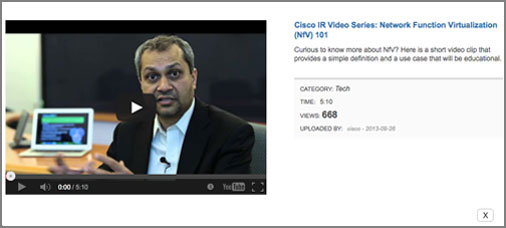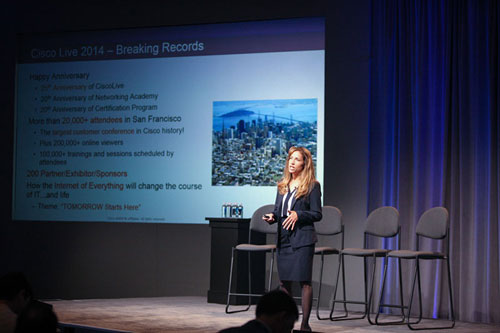Tech giant using video, tech talks and huge investor days to keep investors informed
In March this year Cisco announced plans to muscle in on the high-growth cloud computing market, revealing a planned $1 bn investment over two years. Meanwhile, analysts are questioning how the spread of software-defined networking – a new approach to building and managing networks – will affect the firm’s product sales.
With these and other market transitions to contend with, Cisco has ramped up its IR outreach to help investors understand what it is doing to stay on top of shifts in the tech world. Below, director of IR Marilyn Mora explains how she and her team are keeping the investment community informed with increased outreach and innovative events.
What approaches do you use to keep investors educated about market transitions?
We are focused on driving greater education of investors to make sure they understand those changes being made in the market and how Cisco is going to address them in terms of strategy.
So we plan and do a lot of activities that drive those things home. We make videos for our website and we try to make them less than five minutes long to make them digestible, in recognition of the time a financial investor or analyst has to get up to speed on a particular topic.
We also use those videos to talk about some rather complex topics related to the market transitions. We’re dealing right now with lots of conversations about cloud computing and software-defined networking. Many of our investors tend to be more generalist and it’s hard for them to grasp some of these fairly complex technology topics and acronyms that are always flying around, along with related business impact.
A recent post from Cisco's IR video series
The second vehicle we leverage is going out on the road, which we do quite a bit. We’ve been very aggressive going out on the road, particularly around our software-defined networking (SDN) strategy. We’ve done numerous events over the last seven months or so – at least five roadshows and two tech talks – just to explain exactly what it is and how we are going to address it.
What are tech talks?
We select a sell-side analyst who covers the company, and partner with him/her to craft a discussion, say on SDN. So we do a fireside chat-style discussion – we open it up to investors to ask questions. It’s probably about 45 minutes to an hour, and it’s open to the public and webcast.
Following that tech talk, we host a number of investor meetings ‒ and we’ve seen a lot of success. Before, we would do a tech talk as a stand-alone event and then move on. Now we’ve been coupling them with meetings and we find it to be very powerful. Most times, investors don’t want to pose a question on the call, so it’s their chance to say, ‘I listened to what you said and I had some questions on a particular topic’.
What about investor or analyst days?
We host two events a year. Generally, one is a financial analyst day, typically held in December, and we leverage that event as a business model and strategy update discussion with our CEO and CFO. And then we provide a high-level overview of some of the dynamics of the technology market and the growth opportunity afforded to Cisco.
Then six months later we host our investor day at Cisco Live, and that event is really geared toward doing what I call a deeper dive into the technology and walking folks through a lot of the concepts, as well as explaining what our strategy is and how we expect to benefit. When investors go to the Cisco Live investor event, not only are they there for the technology deep dive, but they can also get an appreciation for the customers in attendance. At the last event, we had about 25,000 customers.
Cisco's director of IR Marilyn Mora speaking at Cisco Live
Given the changes taking place at Cisco and within your key markets, have you increased the frequency of your investor interactions?
Absolutely – we’ve increased the amount of outreach and engagement we’ve done with investors. If I compare 2014 with the past couple of years, I’d say there’s probably a two-times increase in the number of events we’ve done, whether it’s investors we’ve been hosting from bus tours here in the company, going out on the road or hosting a variety of calls with investors. And again it’s trying to help the company stand out in the marketplace, cut through all the noise they may be hearing.
From a technology standpoint, we do telepresence-hosted meetings, which allow us to get scale and mass in a short amount of time to update folks. And then it’s always very important to have prioritization on what it is we focus on within our group and our team to drive the maximum impact for Cisco. We have changed our priorities as these market transitions were extremely important for investors to understand our positioning.
How do you track your progress in the IR team?
Beyond the anecdotal feedback, research notes and notes we get from the investment community, a formal measure we leverage is something we have in-house called our Investor Perception Index (IPI).
We do this generally on a quarterly basis. We go to the investor audience – each IR team member owns a set of relationships – and we reach out to those investors and go through a series of questions to see whether our message and strategy are resonating, and investigating areas of opportunity for us to improve.
One to five is the rating scale, with five being great and one suggesting we’ve really got some improvement to do, and then every quarter we look at how the score is moving as well as the comments that come out of those interviews. We present that both to the executive team and the operating committee, so they understand exactly where we are from an investor standpoint.
How’s the IPI going at the moment?
We’ve been seeing a bit of improvement. If I go back to November 2013, we had some tough news to deliver to the Street pertaining to our guidance, and following that the results were fairly tempered, seeing as the Street had anticipated more. Since then, given all the education we’ve been doing and all the vehicles we’ve spoken about, tied to better execution and the results, we’ve seen an uptick in the scores.
At the onset there was a lack of understanding and appreciation about Cisco’s ability to navigate those transitions. Fast-forward to where we are today, and there is less anxiousness, nervousness and emotion around these topics. Investors are increasingly more comfortable with our strategy and how we are positioned than they were eight months ago.










